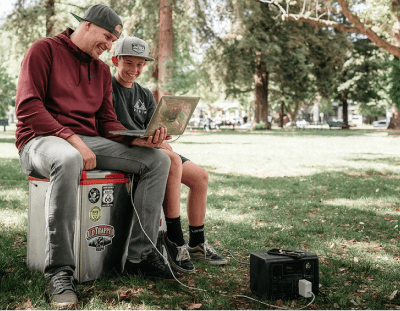Going on an adventure in your 4x4 vehicle is one superb way to spend sunny weekends or holiday seasons. These 4WD rides are built with extra strength for off-road situations and any kind of outdoor terrain-definitely suited for those who love a good road trip. Naturally, this type of vehicle would need a powerful starter battery for a good engine kickstart but aside from this, it's also good to put in an auxiliary battery, particularly if you have additional gear and accessories to power.
Normally, secondary batteries or "house batteries" should ideally be a deep-cycle battery, as it has a higher usable capacity of up to 80%. This allows your electronic equipment on board to be powered up for a longer period, especially in off-grid settings where access to mains power is not readily available. You can either go for an AGM deep-cycle battery for this or a lithium deep-cycle battery but if you want long-lasting quality, it's best to invest in a lithium battery instead despite the higher price, such as a LiFePO4 battery. Paired with your vehicle's main battery, this kind of arrangement is called a 4x4 dual battery setup.
Why Do 4x4 Vehicles Need Two Batteries?
When you say 4x4 battery, this actually pertains to either the car battery for the engine, an auxiliary battery for the accessories and appliances or a dual battery that functions as both. A 4x4 dual battery system or 4WD dual battery setup ensures that you won't end up with a flat car battery-no one wants to be stuck on the road, especially in a remote location! Your car battery is not really meant for any other application aside from starting the engine. First, it has thinner plates and second, vehicle batteries provide short, concentrated bursts of energy that are not suited for longer periods of use. If you use this to power whatever appliances you have like a fridge, for example, your battery will be drained in no time. Pairing it with a deep-cycle battery will keep everything you need running from the engine down to your gadgets. These two also function and charge separately through the help of a battery isolator. Most of the time, 4x4 vehicles use 12V dual battery systems. Some of the most popular 4x4 dual battery setups or dual battery kits in the market as of present include the Kings Dual Battery Kit and the Redarc Dual Battery System.
How Do You Install a 4x4 Dual Battery Setup?
Step 1: Decide where you want to mount the second battery and make sure that you have enough wire for all needed connections. It's also safer to keep your battery pack away from anything that heats up.
Step 2: Disconnect your battery from any load or connection before starting the installation process.
Step 3: Set up the Voltage Sensitive Relay (VSR). This serves as the controller for both batteries so it should be in an area that is easily accessible and away from the heat as well. This usually has a mounting plate already, so you just need to drill the holes and secure it with screws. Take the end of the red cable with lugs and measure it so you have enough wire to run from the centre of the mounting plate to the positive terminal of your primary battery.
Step 4: Cut the cables accordingly and follow the same instruction but this time leading to the positive terminal of the secondary battery.
Step 5: Fit the lugs into the cables by stripping 15mm of insulation and arranging them in place with a crimping too.
Step 6: Earth the black wire attached to the VSR
Step 7: Connect your main battery to the VSR. Remember, the cable of your main battery that will be attached to the VSR is marked with a red dot while the cable of your auxiliary battery is marked with the words “positive second battery.”
Step 8: Earth the second battery and attach the VSR to the mounting plate using longer screws.
Step 9: Attach the negative terminals first to the car battery and then to the secondary battery.
Step 10: Time to test your dual battery setup! You can use a multimeter for easier voltage reading. Start the vehicle and check the voltage level of the main battery. When it reaches 13.3V, you should hear a relay click and see the red light switch on to indicate that it is now connected to the second battery. Now switch off the engine and take a voltage reading again. Once it drops below 12.8V, the relay should automatically disconnect.
More from Outbax
Whatever recreational vehicle you have, going for a dual battery system is usually a good idea. Here at Outbax, we have a collection of affordable deep-cycle batteries perfect for caravan battery setups or as a lithium RV battery. If you own a 4WD vehicle instead, our power packs also make excellent service batteries. Check out our slim deep-cycle battery. It may be narrower than what you're used to, but just as powerful as bigger batteries! We have other power sources too, including solar panels for those who prefer renewable energy and inverter generators for those who want to skip the installation part. Outbax houses wallet-friendly, quality camping equipment to accommodate every adventure lover, so make sure to check out our items before your next outdoor trip!







